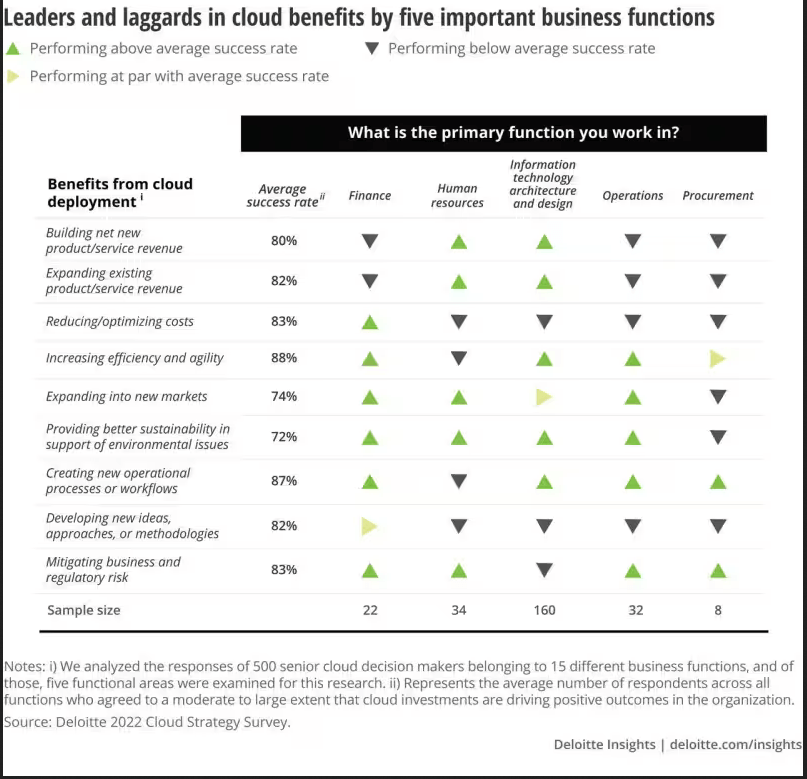Cloud computing is a hot topic in the C-suite, with leaders recognizing its potential to propel businesses forward. Deloitte research highlights this, with 72% to 88% of surveyed executives agreeing cloud investments offer a competitive edge. However, a crucial element is often overlooked: maximizing these benefits across all business functions.
Deloitte’s data reveals an interesting trend. While individual departments excel in areas aligned with their expertise when using cloud solutions (e.g., finance departments see cost advantages with cloud-based ERPs), they often underperform in other areas. This siloed approach attracts significant missed opportunities.
For instance, a finance department focused solely on cost optimization might overlook leveraging cloud-based customer data analytics to personalize recommendations and drive upsell opportunities. This untapped potential translates to lost revenue streams.
The key: Collaboration for unified success
The true power of cloud computing lies in a unified approach fostered by C-suite leadership. By breaking down departmental silos and encouraging collaboration, businesses can unlock the full spectrum of cloud benefits. Here’s how:
- Cross-functional synergy: Collaboration allows departments to combine their strengths. Finance’s cost-cutting expertise can be paired with marketing’s customer insights to optimize pricing strategies and identify areas for cost reduction without compromising revenue.
- Holistic cloud strategy: A unified approach ensures a strategic cloud implementation that aligns with overall business goals. This goes beyond just cost savings and encompasses revenue generation, innovation, and improved customer experiences.
- Unleashing innovation: When departments work together, they can leverage the cloud’s scalability to explore new ideas and launch initiatives faster. This fosters a culture of innovation, giving businesses a competitive edge.
By fostering a collaborative cloud culture, C-suite leaders can transform cloud investments into a powerful driver of business success. This approach ensures all departments benefit, leading to a more efficient, innovative, and ultimately, a more profitable organization.

Source: Deloitte
Benefits of cloud managed services
Cloud managed services offer a multitude of advantages for businesses, empowering them to:
- Increase agility and scalability: Cloud services provide on-demand resources that can be easily scaled up or down to meet fluctuating business needs. This agility enables organizations to respond swiftly to market changes and opportunities.
- Reduce IT costs: Cloud services eliminate the need for upfront investment in hardware and software, and managed services reduce the burden of ongoing IT maintenance. This translates to significant cost savings.
- Improve security and compliance: Cloud providers invest heavily in security measures and maintain rigorous compliance certifications. By leveraging these safeguards, organizations can enhance their data security posture and meet industry regulations.
- Enhance disaster recovery: Cloud services offer built-in redundancy and geographically distributed data centers. This ensures business continuity in the event of disruptions or outages.
- Simplify IT management: Managed cloud services handle routine maintenance tasks, freeing up internal IT staff to focus on strategic initiatives.
Cloud benefits for c-suite
Cloud adoption empowers C-suite executives to make significant strides across various aspects of the business:
- Improved decision making with real-time data insights: Cloud-based analytics platforms provide access to real-time data, enabling data-driven decision making throughout the organization.
- Increased innovation and agility: The cloud’s inherent scalability fosters a culture of experimentation and innovation. Businesses can explore new ideas and initiatives without significant upfront investments.
- Enhanced operational efficiency: Cloud services streamline workflows and automate tasks, leading to improved operational efficiency and productivity across departments.
- Reduced IT costs and improved ROI: Cloud adoption reduces IT expenditures and frees up capital for core business functions. This translates to a better return on investment (ROI).
- Scaled resources to meet business demands: Cloud resources can be easily scaled to accommodate business growth or seasonal peaks, ensuring optimal performance and cost-effectiveness.
Companies that adopt cloud managed services can realize up to a 69% decrease in unplanned downtime.
Cloud benefits: A departmental deep dive for c-suite collaboration
Cloud computing offers a symphony of advantages, but to capitalize, C-suite leaders need to ensure each department plays its part. Cloud benefits for C-suite are different departmentally.
Here’s a breakdown of how different executives can maximize cloud benefits for their areas and collaborate for overall success:
CFOs: Cost champions with revenue potential
Finance departments lead in extracting cost-saving benefits from the cloud. However, there’s an untapped opportunity: revenue generation. By collaborating with CHROs, CFOs can leverage cloud-based employee training programs to cultivate an innovation mindset within the workforce. Imagine a cloud-powered learning platform empowering employees to identify new sales opportunities!
CHROs: Culture builders with sustainability focus
HR professionals excel at fostering a culture that drives revenue from existing products and services. This strength aligns with their role in promoting sustainability. Partnering with COOs, CHROs can leverage cloud-based data analytics to optimize workflows and reduce environmental impact.
CIOs: Tech enablers with risk management needs
IT departments possess the expertise to guide other functions in developing new products and services through technology and agile methodologies. However, they may require support in navigating business and regulatory risks. CIOs can bolster their cloud strategy by collaborating with CPOs and COOs to establish cloud security protocols and risk mitigation procedures. Remember, security needs to be embedded from the initial design stages (“security by design”).
COOs: Efficiency experts looking to expand
Operations are masters of efficiency, agility, and regulatory compliance. However, expanding product lines and optimizing costs might require external expertise. COOs can bridge these gaps by collaborating with CHROs, CFOs, and CIOs. For instance, CHROs can assist with recruiting and upskilling a cloud-savvy workforce, while CFOs can advise on cost-effective cloud vendor contracts.
CPOs: Procurement powerhouse with untapped potential
Procurement departments lead in creating new operational processes and managing risks within the cloud environment. However, they could further enhance their cloud strategy by collaborating with CIOs and CHROs. By adopting cloud-based procurement systems and investing in tech-savvy personnel, CPOs can unlock significant benefits like reduced costs, improved collaboration with suppliers, faster decision-making, and quicker product launches.
C-suite collaboration driving cloud benefits
Given the difference in benefits across business functions, C-suite leaders can help increase their benefit analysis across silos to maximize cloud benefits. While individual departments excel in leveraging specific cloud benefits, maximizing the overall impact requires a strategic shift. C-suite leaders can act as catalysts, fostering collaboration to break down departmental silos.
Here’s the key: Move beyond siloed analysis. By bringing departments together to analyze cloud benefits holistically, C-suite leaders can ensure no valuable opportunity slips through the cracks.








